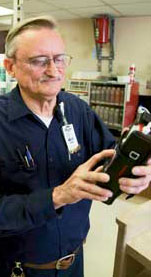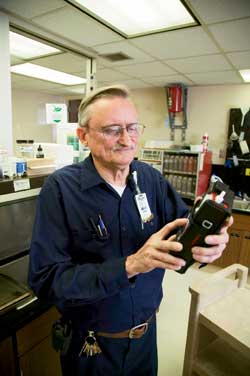
Why Be Concerned with IAQ?
Typical commercial space monitoring occurs monthly or quarterly. Any real estate that is being bought or sold should be evaluated.
 ACCORDING
to the National Human Activity Pattern Survey (NHAPS) as referenced by EPA, Americans spend about 90 percent or more of their time indoors. For this reason, the quality of our indoor air should be of great concern, whether it is in a home, a workplace, or a school, hospital, or medical facility--virtually any indoor environment. Poor indoor air quality can lead to a variety of health problems for any building occupant, especially at-risk populations (those younger than 2 or more than 70 years of age, immune system-compromised individuals, asthmatics, or those with severe allergies). Awareness of the indoor air quality in your environment is the key to properly addressing problems that may arise.
ACCORDING
to the National Human Activity Pattern Survey (NHAPS) as referenced by EPA, Americans spend about 90 percent or more of their time indoors. For this reason, the quality of our indoor air should be of great concern, whether it is in a home, a workplace, or a school, hospital, or medical facility--virtually any indoor environment. Poor indoor air quality can lead to a variety of health problems for any building occupant, especially at-risk populations (those younger than 2 or more than 70 years of age, immune system-compromised individuals, asthmatics, or those with severe allergies). Awareness of the indoor air quality in your environment is the key to properly addressing problems that may arise.
Creating a healthy work environment is important to the overall health of a business. As a business owner or manager, your proper monitoring of indoor air quality can help reduce employee absences and illnesses, which can increase efficiency and productivity. In school settings, indoor air quality affects not only employees, but also children, which can lead to an increase in student and faculty absenteeism.
A safe environment at home is just as important as it is at work and school. The NHAPS study found that on average, 69 percent of the time spent indoors by Americans is in their homes. If individuals do not have a safe environment to come home to, they are increasing their chances of becoming ill while in public settings.
undefined
Bacteria are an important contaminant, especially when they enter the indoor environment through a water intrusion such as a sewage spill or water heater leak.
Types of Contaminants and How They Occur
Indoor air quality comprises much more than many people realize. Common indoor air quality contaminants include mold, bacteria, volatile organic compounds, gases (such as radon and carbon monoxide), and allergens. Mold can occur in an indoor environment for a number of reasons; the most common reason is moisture intrusion.
Moisture intrusion can occur from leaky pipes, floods, spills, and roof leaks, as well as other water intrusions. When moisture enters a confined, dark space where there is a nutrient source and the temperature is adequate, mold will grow. Typically, mold growth is found behind walls, in roofs, and on flooring. While most molds prefer cellulose or other plant materials for a nutrient source, other specialized species such as Histoplasma capsulatum thrive in bird droppings.
Volatile organic compounds (VOCs) are one of the more common indoor air quality contaminants. Many finishings, furnishings, and household products emit VOCs, which can become concentrated because of poor ventilation. Heath effects from VOCs can range from minor irritation to cancer.
When people think of allergens, they usually think of pollen and sometimes pet dander, but there are additional indoor environmental allergens of concern. These allergens include dust mites, cockroaches, rodent excrement, and even latex allergens, which are specific to health care/laboratory settings.
Bacteria occur naturally in almost every living thing. When significant quantities of pathogenic bacteria enter a human being, they can cause serious problems. Bacteria become an important indoor environmental contaminant, especially when they enter the environment through a water intrusion such as a sewage spill or water heater leak. Other common bacterial sources are spas/hot tubs and condensate drain pans in HVAC systems, which can host Legionella or Pseudomonas.
Various gases are also a concern for indoor air quality. Not only are they difficult to detect with our five senses, but also they may enter our indoor environment in a number of ways. Two common gases of concern are radon and carbon monoxide. Radon is a naturally occurring radioactive gas that is produced when uranium in the earth's crust decays. You cannot see, smell, or taste radon, and it has no immediate symptoms. However, prolonged exposure to radon may cause lung cancer. According to the surgeon general and EPA, radon is the second-leading cause of lung cancer in the United States today. Radon sources include earth and rock beneath buildings, well water, and some building materials. Buildings under negative pressure are more susceptible to elevated radon levels. Carbon monoxide (CO) is a colorless, odorless byproduct of incomplete combustion. Common sources of CO include gas heaters, furnaces, and automobile exhaust. Symptoms of excessive CO exposure range from fatigue and chest pain to impaired vision, dizziness, and nausea. CO can be fatal at very high concentrations.
Monitoring IAQ
Indoor air quality is a very site-specific issue and should be monitored as such. Some factors affecting the frequency of monitoring and the types of testing employed are size, location, occupant characterization, activity level and categorization, and, of course, complaints logged.
Typical commercial space monitoring occurs monthly or quarterly, while residential monitoring may be done on a seasonal basis. Any real estate that is being bought or sold should be evaluated.
Mold
Sampling for mold can be accomplished in four different ways: air sampling (including wall cavity sampling), surface, bulk, and dust sampling.
Air sampling involves the use of a high-volume air pump used to pull air across either a slide or an agar plate. The two most common types of media used for sampling are spore traps and the agar plate, which is used in conjunction with an impactor. Each method will give you slightly different and extremely useful information. Spore traps offer a total spore count, which includes both culturable and non-culturable spores. However, with direct microscopic examination it is impossible to distinguish between the two types of spores or identify below the genus level. The agar plate (a petri dish with a nutrient source) method reveals only the culturable fungi. This allows for further evaluation of the mold to the species level. Wall cavity sampling for mold can be accomplished with the spore trap and specialized adapters made to fit inside small openings. Wall cavity sampling is an important non-destructive way to sample for molds behind enclosed walls.
Surface sampling can be achieved in several ways. Two of the most popular ways include tape lifts and swabs. Tape lifts allow for microscopic examination of the surface sampled. By placing a clear piece of tape on a surface, an investigator can literally "lift" the spores off the wall and send them into the laboratory for a direct microscopic identification. However, just like the spore trap, the microscopic examination includes both culturable and non-culturable spores and cannot distinguish between the two types. Swab sampling offers direct screen, as well as the ability to culture the sample on an agar plate. The investigator swabs the suspect area and sends the sample into the laboratory where it can be both examined directly and plated and incubated for culturable analysis.
Bulk samples include pieces of substrates such as wood, drywall, and carpeting. Bulk analysis is similar to that of swab analysis. A lift can be done off the surface of the bulk sample to allow for a direct microscopic screen, or the piece can be placed in a solution to extract biological contaminants and cultured on an agar plate for culturable analysis.
Mold analysis from dust is also common. It may not provide a true assessment of current air quality conditions, but it does provide a great deal of information on the air quality "history" of that space. Collection devices allow an investigator to gather at least one gram of dust to send to the laboratory for analysis. This dust can be analyzed through direct microscopic examination or through dilution and plating methods for culturable analysis.
VOCs and Allergens
Sampling for VOCs can be accomplished in several ways, including the use of tedlar bags, charcoal tubes, passive badges, and mini canisters. The most convenient way of sampling is with silonite coated mini canisters. Mini canisters are cleaned and negatively pressurized by the laboratory. When a flow regulator is attached to the valve on the end of the canister, air is pulled into the canister. Once the sample is taken, the investigator sends the entire canister back to the laboratory, where the air sample inside is extracted and results of VOCs found inside the canister are reported.
Allergens can be collected in a number of ways, though the most common method is through dust sampling. Again, the investigator must gather at least one gram of dust to send to the laboratory for analysis. Dust is then analyzed using immunoassays, otherwise known as the ELISA method. Often, if enough dust is gathered, several analyses may be combined. Mold analysis and allergen screens may be preformed on the same dust sample.
Bacteria and Gases
Sampling for bacteria can be accomplished in the same four ways as mold: air, surface, bulk, and dust. Air sampling involves the use of a high-volume air pump used to pull air across an agar plate located inside a microbial sampler (impactor). This agar plate method enables the laboratory to offer a variety of enumeration and identification analyses. Surface sampling for bacteria involves swab sampling, which offers the same results as the agar plate from the microbial sampler. Bulk and dust analyses are similar to that of a swab analysis: The bulk or dust sample is placed in a solution to extract biological contaminants and cultured on an agar plate for bacteria culture and gram stain identification.
Monitoring the indoor air for gases is an evolving science. Today we have photo-ionization detectors (PIDs), and other gas sensors that give accurate, real-time results for the detection of gaseous indoor air contaminants. "Smoke detector" type gas sensors for radon and carbon monoxide are even available directly to the homeowner.
Ultimately, IAQ is not just a "mold issue." With such a variety of indoor air contaminants and the varying susceptibility of individuals to each, everyone should be concerned about his or her indoor environment. From building owners and managers to building occupants and, especially, health and safety officers, everyone should be educated about his indoor environment and should work to keep himself and his fellow occupants safe.
This article originally appeared in the May 2007 issue of Occupational Health & Safety.